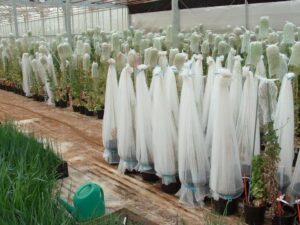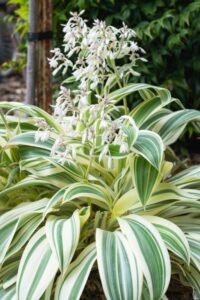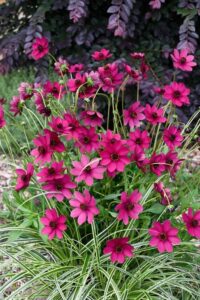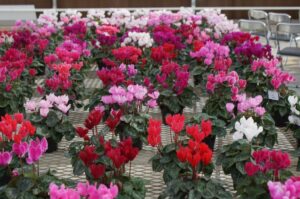Why innovation takes time
By John Fitzsimmons
Next time you see, seek or get offered a new greenlife development, spare a thought for the time, expertise and effort that went into delivering that innovation. It could have been up to a decade or more!
At this point in time many people in our world anticipate rapid, even instant, responses to needs and wants. This is obviously unrealistic when it comes to giving us better performing, or more desirable greenlife.
For millennia we relied on natural processes to produce new variants derived from existing plant species. Later we learned how to work with nature to progress the evolution of plants. As one example, while plant breeders artificially (mechanically) cross pollinated varieties to produce new lines, the multiplication and ‘bulking up’ of new seed lines was accelerated by moving seed between northern and southern hemispheres to utilise more than one growing season in a year.

However, with improved knowledge and technologies, especially with more recent advances in genetic understanding and abilities to manipulate genetic resources, we have gained more control over the direction and pace of improvements.

Plant breeding is now a major global industry. For example, the World Horti Centre’s Plantus trade association represents 350 specialist plant breeding, propagation and production companies in the Netherlands alone! Not all are Dutch owned but that is where much knowledge and infrastructure “is within arm’s reach”. It is the world’s biggest exporter of seeds and young plants, representing 200 years of focused plant improvement resulting in “an impressive knowledge infrastructure”.
Plantus’ Managing Director, Niels Louvaars, observed: “Plant breeding is nothing but knowledge. Seeds are knowledge. The more qualities you breed into (plants) the more beneficial they are.”
The industry’s participants invest much in R&D while a strong Dutch regulatory accreditation infrastructure reinforces and guarantees quality standards. It embraces testing and quality control, plus plant breeders rights for breeders to control and maintain their innovations. This is reflected in reliability (repeatable performance), plant values and sustainability including adaption to climate change – including water requirements and disease resistance.
While The Netherlands is (arguable) the world technical centre for plant breeding and production, plant breeders and plant breeding facilities are spread right across the world not the least in Australia and New Zealand. There are solo independent plant breeders (especially in niche categories), Family and Genus specialists, methodology specialists and specialty propagators, regional and national operators, and global genetics companies. But whatever genus or technology is involved, the road from concept, desire or need to a commercial market usually follows most, if not all, of the following steps:
- Identifying and specifying what is needed or sought, be it a colour, form, seasonality or other trait
- Identifying and collecting appropriate material from plant stock in hand, the wild or other genetic collection (e.g. international seed/genetics companies)
- Breeding by the appropriate means
- Propagation by the appropriate means
- Selection of plants exhibiting the desired traits or improvements
- Testing under the anticipated growing conditions for performance, disease resistance and other relevant cultural factors
- Final selection based on desired traits based on eligible candidates
- Multiplying stock and accelerating production volumes
- Securing Plant Breeders Rights and other intellectual property (IP) as appropriate

- Commercialisation – this has become a significant and a growing part of the plant breeding business. It embraces PBR, IP, production and sales licencing, promotion, packaging, merchandising, logistics and more
- Sales and marketing to trade and retail demand, export where appropriate (see Commercialisation above)
Locally, companies like Plant Management Australia (PMA) exist “to provide professional guidance for breeders and finders of unique garden and landscape plants. The company’s people travel regularly to visit breeders, growers and partners to foster relationships, maintain quality control and explore new opportunities for plants from Australasia and beyond. They are especially involved with licensing, marketing and distribution”. Similarly, Anthony Tesselaar Plants does much the same, only ‘within house’: “working with a close network of breeders throughout the world to find new and distinctively different plants to add to our very special collection. Our plants are more than just lovely – each has also passed long term and rigorous testing in trial gardens around the world (to prove) that these gorgeous plants aren’t fussy or tricky to grow. They are trialled over several years to ensure they are environmentally friendly too…”.

At industry level, in production horticulture, companies like the New Zealand-based Prevar “was established to develop and commercialise new apple and pear varieties for licensing in New Zealand and around the world.” It is a private joint venture company owned by industry, its shareholders being New Zealand Apples & Pears Incorporated, Plant & Food Research (New Zealand), and Apples and Pears Australia Limited. Its business focuses on four core areas: consumer insights-driven innovation, a world class breeding programme, customer-centred commercialisation, and industry/category leadership. Prevar seeks to “maintain and enhance a competitive advantage as a value creator”.
This all goes to demonstrate why good plant breeding takes time: due to nature’s limitations, business needs, and a changing world among many other factors.
In the more practical world for many Hort Journal readers though are the arrival of appealing and needed new lines to produce and sell. For example, at the recent GIG 2024 event, Howard Fox from Plant Growers Australia (PGA) said they were proud to present new releases every year – “as many as we can, and take a lot of pride in what we do. We do try and test them really well”.
“We did more than 30 new varieties in 2023 which was a mix of lines we bred ourselves and others which were new to our portfolio. This year in 2024 we have more than 50 new varieties. We keep the industry informed through the year as they arrive.”


PGA announced a world first release in its Moon Series® of Convolvulus – the uniquely petalled ‘Starry Moon’ which also delivers a very long consistent flowering time, while being compact and dense with a spreading-trailing habit.
“Convolvulus can be weedy and quite sparse so the aim of our breeding was to improve the compactness,” Howard commented. “The aim was to get a dense, mounding groundcover instead of a really sparse running habit.”
“The Moon Series program which has been running since 2000 involved breeding by us in Australia by our dedicated plant breeder Steve Eggleton. The first release was ‘Moroccan Beauty’ later aligned as ‘Moroccan Moon’. The uniquely petalled ‘Starry Moon’ took ten years and six breeding generations before the final selection in 2021. It took another three years to the point of release!”
Similarly, a forthcoming new addition to the Lavinnova® collection – the compact PGA Australian-bred ‘Baby Pink Princess’, features dark green foliage against which the masses of baby pink flowers, with broad wings, covering the whole plant really ‘pop’. This also took eight years to reach market since initial selection in 2016.
While form, flowering and an enhanced colour range were focuses on the Moon Series program, PGA’s new Arthropodium Moon Beam® breeding aimed for vibrant, clear variegation of foliage, and a pink star bud which opens to a white star flower. Beyond this, PGA’s new Cosmos ‘Cherry Chocolate’ offers a “calorie-free chocolate fragrance”.
“Things don’t happen overnight. The team makes a fantastic effort to get it to what it is – they don’t rush, they really know what they want to get, making sure it’s true to what they say before getting it out into the market.”
“That gives you a real bit of history and perspective on how long it takes, from a breeding perspective to the market. We can’t just say ‘yes, we’ll bring that out’, it takes a lot of testing in gardens and in pot production trials.”

